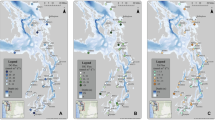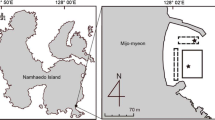Abstract
The seasonal influence of tidal regimes on sulfidic conditions was studied in intertidal environments from a mangrove estuary in Northern Peru. Along two sampling stations, creek water and sediment cores were collected during the dry and wet seasons at all tidal phases (ebb, low, flow, and high tides). Physical-chemical parameters were measured in the creek water (temperature, salinity, pH, Eh, and DO), whereas pH, redox potential (Eh), and total organic matter contents were obtained from the sediment cores. In addition, total dissolved sulfide content ∑ (H2S, HS−, H2−) was measured from sediment pore water. During the dry and wet seasons, the creek water pH, Eh, and dissolved oxygen were lowest in low tide, whereas oxygenated conditions and higher pH and Eh values prevailed in high tide. The total organic matter content in sediments was higher during the dry season, with the highest contents observed in the seaward station. Higher average ∑H2S (landward station, 243.1 ± 234.9 μM L−1; seaward station, 544.9 ± 174.4 μM L−1) were noted during wet season compared to dry season (landward station, 5.3 ± 4.5 μM L−1; seaward station, 430.2 ± 435.1 μM L−1). These ∑H2S contents increased towards the bottom of the sediment column, reflecting the anaerobic decomposition of the organic matter and sulfate reduction. This study provides insight to the geochemical dynamics of intertidal mangrove sediments that are sensitive to fluctuating reducing and sulfidic conditions, oscillating at time scales of minutes to hours.








Similar content being viewed by others
References
Alongi DM (2009) The energetics of mangrove forests. Springer science, New York, 179pp. https://doi.org/10.1007/978-1-4020-4271-3
Alongi DM (2014) Carbon cycling and storage in mangrove forests. Annu Rev Mar Sci 6:195–219
Bianchi N (2007) Biogeochemistry of estuaries. Oxford university press, New York, p 720
Black, CA (1965) Methods of soil analysis: Physical and mineralogical properties, including statistics of measurement and sampling. American Society of Agronomy, Madison, p 1357
Black KD, Shimmield GB (2003) Biogeochemistry of marine systems. Blackwell Publishing, England, p 372
Borges AV, Djenidi S, Lacroix G, Theate GJ, Delille B, Frankignoulle M (2003) Atmospheric CO2 flux from mangrove surrounding waters. Geophys Res Lett 30 1558pp
Bouillon S, Boschker HTS (2006) Bacterial carbon sources in coastal sediments: a cross-system analysis based on stable isotope data of biomarkers. Biogeosciences 3:175–185
Bouillon S, Borges AV, Casteneda-Moya E, Diele K, Dittmar T, Duke NC, Kristensen E, Lee SY, Marchand C, Middelburg JJ, Rivera-Monroy VH, Smith TJ III, Twilley RR (2008) Mangrove production and carbon sinks: a revision of global budget estimates. Glob Biogeochem Cycles 22:GB2013
Breithaupt JL, Smoak JM, Smith TJ III, Sanders CJ (2014) Temporal variability of carbon and nutrient burial, sediment accretion, and mass accumulation over the past century in a carbonate platform mangrove forest of the Florida Everglades. J Geophys Res Biogeosci 119:2032–2048. https://doi.org/10.1002/2014JG002715
Chmura GL, Anisfeld SC, Cahoon DR, Lynch JC (2003) Global carbon sequestration in tidal, saline wetland soils. Glob Biogeochem Cycles 17:1–12
Cline JD (1969) Spectrophotometric determination of hydrogen sulfide in natural waters. Limnol Oceanogr 14:454–458
Fossing HR, Jorgensen BB (1989) Measurement of bacterial sulfate reduction in sediments: evaluation of a single-step chromium reduction method. Biogeochemistry 8:205–222
INRENA (2011) Plan Maestro del Santuario Nacional Los Manglares de Tumbes 2007 - 2011. Intendencia de Áreas Naturales Protegidas 175pp
Kristensen E, King GM, Holmer M, Banta GT, Jensen MH, Hansen K, Bussarawit N (1994) Sulfate reduction, acetate turnover and carbon metabolism in sediments of Ao Nam Bor mangrove, Phuket, Thailand. Mar Ecol Prog Ser 109:245–255
Kristensen E, Bouillon S, Dittmar T, Marchand C (2008) Organic carbon dynamics in mangrove ecosystems: a review. Aquat Bot 89:201–219
Lymo TJ, Pol A, Den-camp H (2002a) Sulfate reduction and methanogenesis in sediments of Mtoni mangrove forest, Tanzania. AMBIO J Hum Environ 31:614–616
Lymo TJ, Pol A, Den-camp H (2002b) Methane emission, sulphide concentration and redox potential profiles in Mtoni mangrove sediment, Tanzania. Western Indian Ocean J Mar Sci 1:71–80
McKee KL (1993) Soil physicochemical patterns and mangrove species distribution - reciprocal effects? J Ecol 81:477–487
McKee KL, Mendelssohn A, Hester MW (1988) Re-examination of porewater sulfide concentrations and redox potentials near the aerial roots of Rhizophora mangle and Avicennia gennillans. Am J Bot 75:1352–1359
Mendoza U (2007) Dynamics of phosphorus and sulphur in a mangrove forest in Bragança, North Brazil. PhD Thesis. Bremen University - Germany
Morera S (2014) Magnitud, frecuencia y factores que controlan los flujos sedimentarios desde los Andes Centrales Occidentales hacia el oce’ano Pacı’fico peruano. Tesis para la obtencion del grado de Doctor en Recursos Hıdricos. Universidad Nacional Agraria La Molina, Lima, Peru
Nickerson NH, Thibodeau FR (1985) Association between porewater sulfide concentrations and the distribution of mangroves. Biogeochemistry 1:183–192
Ovalle ARC, Rezende CE, Lacerda LD, Silva CAR (1990) Factors affecting the hydrochemistry of a mangrove tidal creek, Sepetiba Bay, Brazil. Estuar Coast Shelf Sci 31:639–650
Pérez A (2014) Influencia del régimen hídrico y de las condiciones geoquímicas sobre la comunidad y el flujo energético del meiobentos metazoario de los sedimentos intermareales y submareales de los Manglares de Tumbes. Master thesis. Universidad Peruana Cayetano Heredia. Lima - Perú
Pérez A, Gutiérrez D, Saldarriaga MS, Sanders JC (2017) Hydrological controls on the biogeochemical dynamics of a Peruvian mangrove system. Hydrobiology 803:69–86. https://doi.org/10.1007/s10750-017-3118-2
Sanders CJ, Santos IR, Maher DT, Sadat-Noori M, Schnetger B, Brumsack HJ (2015) Dissolved iron exports from an estuary surrounded by coastal wetlands: can small estuaries be a significant source of Fe to the ocean? Mar Chem 176:75–82
Sanders CJ, Santos IR, Maher DT, Breithaupt JL, Smoak JM, Ketterer M, Call M, Sanders L, Eyre BD (2016a) Examining 239-240Pu, 210Pb and historical events to determine carbon, nitrogen and phosphorus burial in mangrove sediments of Moreton Bay, Australia. J Environ Radioact 151:623–629
Sanders CJ, Maher DT, Tait D, Williams D, Holloway C, Sippo J, Santos IR (2016b) Are global mangrove carbon stocks driven by rainfall? J Geophys Res Biogeosci 121:2600 9
Spalding M, Kainuma M, Collins L (2010) World Atlas of Mangroves. Earthscan Publications, London, p 319
Acknowledgements
This study was carried out within the framework of the project “Impacto de la Variabilidad y Cambio Climático en el Ecosistema de Manglares de Tumbes” supported by the “International Development Research Centre (IRDC)” of Canada under management of the “Instituto Geofísico del Perú (IGP),” in cooperation with the “Instituto del Mar del Perú (IMARPE)” and the “Universidad Peruana Cayetano Heredia (UPCH).” The authors acknowledge the “Cátedra CONCYTEC program” in “Ciencias del Mar” that funded the Master Program in Marine Sciences at UPCH. Detailed geochemical analyses were supported by the IRDC and IMARPE. AP is supported by the “Fondo Nacional de Desarrollo Cientifico Tecnologico y de Innovacion Tecnológica” (Fondecyt, Peru), through the MAGNET research program. CJS is supported by the Australian Research Council (DE160100443). We would like to thank our colleagues Dr. Ken Takahashi, Ernesto Fernández, Wilson Carhuapoma, Percy Montero, Rubén Alfaro, Manuel Vera, and Dr. Jorge Cardich who provided us with invaluable help.
Author information
Authors and Affiliations
Corresponding authors
Rights and permissions
About this article
Cite this article
Pérez, A., Gutiérrez, D., Saldarriaga, M.S. et al. Tidally driven sulfidic conditions in Peruvian mangrove sediments. Geo-Mar Lett 38, 457–465 (2018). https://doi.org/10.1007/s00367-018-0549-3
Received:
Accepted:
Published:
Issue Date:
DOI: https://doi.org/10.1007/s00367-018-0549-3




